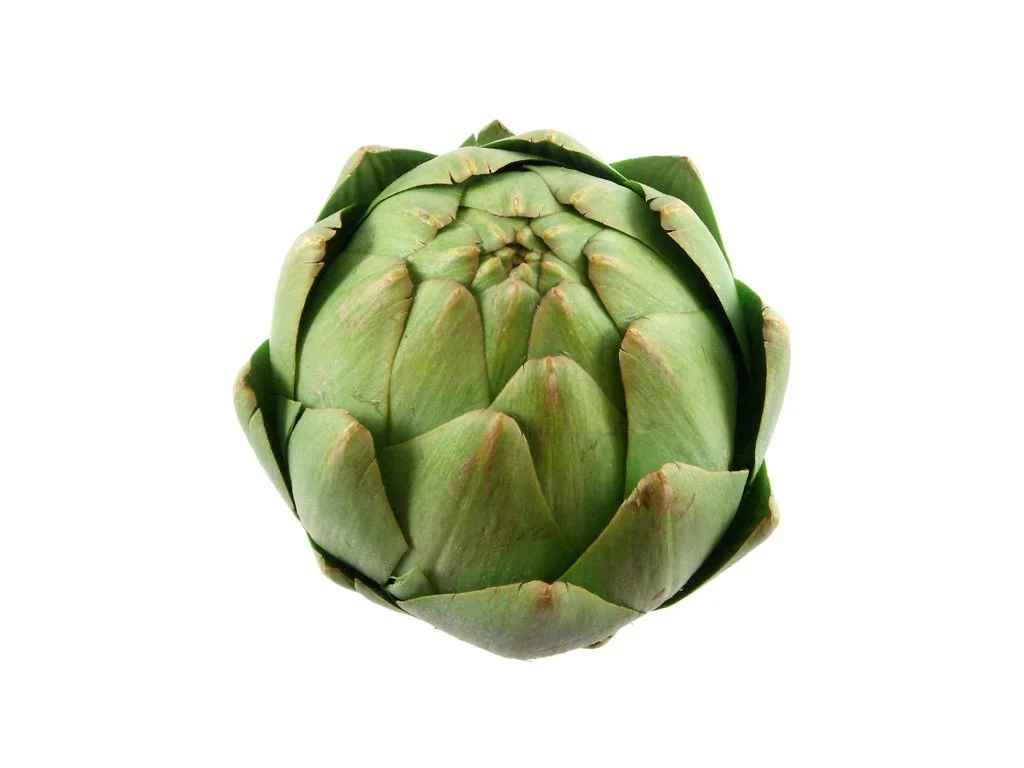Artichoke
A plant of the composite flower family, the artichoke grows wild in the south of Europe and is cultivated in the United States, primarily in California.
Although artichokes are generally available throughout the year, the peak season is from March to May, with a smaller crop produced in October.
Buying Fresh
Choose globes that are dark green, heavy, and have "tight" leaves. Don't select globes that are dry looking or appear to be turning brown. If the leaves appear too "open" then the choke is past its prime.
Choose artichokes that are heavy for their size.
Harvest
Most of the annual artichoke crop is harvested from March through May. There is a smaller harvest from November through mid-December.
The fall crop tends to look different from the spring crop -- the artichoke is more pointed, has longer thorns and the leaves tend to be more open.
When harvesting, they are cut from the ground so as to leave an inch or two of stem. Artichokes possess good keeping qualities, frequently remaining quite fresh for two weeks or longer.
How To Clean and Prepare Artichokes
Tap the choke upside down in the sink. This will remove anything that may have made this artichoke a home. With most commercial grown chokes this is not usually an issue. But, if you or a friend grow artichokes you'll find earwigs love to live in the leaves (if grown organically).
Remove all but 5–10 mm or so of the stem and cut away about a quarter of each scale with scissors. This removes the thorns that can interfere with handling the leaves when eating. Then, the artichoke is boiled or steamed until tender, about 15–45 minutes. If boiling, salt can be added to the water, if desired. It may be preferable not to cover the pot while the artichokes are boiled, so that the acids will boil out into the air. Covered artichokes can turn brown due to the acids and chlorophyll oxidation. In France, artichokes are very popular deep fried. In Italy, artichoke hearts in oil are the usual vegetable for spring in the 'Four Seasons' pizza (with olives for summer, mushrooms for autumn and prosciutto for winter).
How To Eat an Artichoke
Artichoke eating is a hands-on affair and another case in life where the "journey is as important as the destination." Pull each leaf off the choke and hold the pointed end between your fingers and drag the leaf between your teeth. Most of the edible portion is on inside bottom 1/3 of the choke leaf. When you serve artichokes it's nice to put a bowl on the table for the discarded leaves unless your serving plate is large enough to stack the leaves on the side.
The leaves closest to the heart of the choke are very tender and depending on the size and age of the choke you can frequently eat the whole cluster of leaves.
Artichokes are commonly served with a dip such as lemon-butter, or mayonnaise.
Artichoke Hearts
The heart, or flower, of the artichoke lies at the center of all the leaves. Once you see a bed of fuzzy or hair like strands you've hit the heart. Scoop out the fuzz with a spoon and discard. The rest of the base of the choke is edible, referred to as the heart. This is the favorite part of the artichoke for some people.
How To Store Artichokes
Fresh artichokes should be put in a plastic bag, unwashed, and refrigerated. It is best to use them within 4 days of purchase. If you grow your own then cut them right before you cook them.
Baby Artichokes
Baby artichokes are fully mature artichokes that grow closer to the ground, sheltered by the larger leaves on the plant. They are easy to cook and prepare because the inner fuzzy portion of the choke does not develop.
Growing
Artichokes can be produced from seeds or from vegetative means such as division, root cuttings or micropropagation. Though technically perennials which normally produce the edible flower only during the second and subsequent years; certain varieties from seed can be grown as annuals, producing a limited harvest at the end of the first growing season, even in regions where the plants are not normally winter hardy.
This means that home gardeners in northern regions can attempt to produce a crop without the need to overwinter plants with special treatment or protection. The recently introduced hybrid cultivar 'Imperial Star' has been bred to produce in the first year without such measures. An even newer cultivar, 'Northern Star', is said to be able to overwinter in more northerly climates, and readily survive sub-zero temperatures. A second generation of new hybrid cultivars was bred during the last decade, much more homogeneous and stable than the former and more suitable for professional growers.
Commercial culture is limited to warm areas in USDA hardiness zone 7 and above. It requires good soil, regular watering and feeding plus frost protection in winter. Rooted suckers can be planted each year so that mature specimens can be disposed of after a few years, as each individual plant only lives a few years. The peak season for artichoke harvesting is the spring, but they continue to be harvested throughout the summer, with another peak period in mid autumn.

